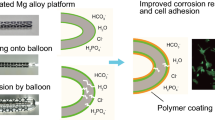Abstract
Drug eluting stents (DES) have shown efficacy in reducing restenosis after angioplasty followed by application of a coronary stent. However, polymer matrices typically used for immobilizing drugs on the stent surface may cause irritation and have limited drug loading capacity. In contrast, drug loading into micro- or nanopores created within the stent material could avoid these problems. We present a technology based on electrochemically induced pitting corrosion to form pores in medical grade steel, followed by loading with rapamycin. This process is applied to pore formation and drug loading in coronary stents consisting of L605 medical steel. Sustained release of the drug over 28 days at rates comparable to established DES was demonstrated. This technology is capable of creating pores with well-defined pore size and filling of these pores by a drug employing a crystallization process thus completely avoiding polymer matrices to immobilize drugs. Electrochemically induced pitting corrosion provides a generic means to introduce micro-pores suitable as drug reservoirs into medical grade steel without the need for any further matrix material. Further research will expand these findings to other materials and types of implants that could benefit from the additional function of drug release and/or improved implant/tissue integration.









Similar content being viewed by others
References
Bennett MR. In-stent stenosis: pathology and implications for the development of drug eluting stents. Heart. 2003;89(2):218–24.
Tsujino I, et al. Drug delivery via nano-, micro and macroporous coronary stent surfaces. Expert Opin Drug Deliv. 2007;4(3):287–95.
Cutlip D, Abbott JD. 2015. Drug-eluting compared to bare metal intracoronary stents. http://www.uptodate.com/contents/drug-eluting-compared-to-bare-metal-intracoronary-stents. Accessed 23 Mar 2015.
Capodanno D, Dipasqua F, Tamburino C. Novel drug-eluting stents in the treatment of de novo coronary lesions. Vasc Health Risk Manag. 2011;7:103.
Ernst A, Bulum J. New generations of drug-eluting stents-a brief review. Eur Med J Interv Cardiol. 2014;1:100–6.
Ma X, Wu T, Robich MP. Drug-eluting stent coatings. Interv Cardiol. 2012;4(1):73–83.
Shand JA, Menown IB. Drug-eluting stents: the next generation. Interv Cardiol. 2010;2(3):341–50.
Abizaid A, Costa JR. New drug-eluting stents an overview on biodegradable and polymer-free next-generation stent systems. Circulation. 2010;3(4):384–93.
Aoki J. Complications of polymers on drug-eluting stents: looking toward polymer-free drug-eluting stents. Intern Med. 2015;54(6):549–50.
Variola F, et al. Nanoscale surface modifications of medically relevant metals: state-of-the art and perspectives. Nanoscale. 2011;3(2):335–53.
Preparation method of metal support surface micro blind hole drug-loaded layer. 2008, Google Patents.
Poncin P, et al. Comparing and optimizing Co–Cr tubing for stent applications. In: Proceedings of the materials and processes for medical devices conference. 2004.
Sul Y-T, Byon E, Wennerberg A. Surface characteristics of electrochemically oxidized implants and acid-etched implants: surface chemistry, morphology, pore configurations, oxide thickness, crystal structure, and roughness. Int J Oral Maxillofac Implant. 2007;23(4):631–40.
Schuessler A., et al. Manufacturing of stents: optimize the stent with new manufacturing technology. In: 5th European symposium of vascular biomaterials ESVB. 2007.
Marcus P. Corrosion mechanisms in theory and practice. 3rd ed. Boca Raton: Taylor & Francis; 2011.
Roberge P. Corrosion engineering: principles and practice. New York: McGraw-Hill Education; 2008.
McCafferty E. Introduction to corrosion science. New York: Springer; 2010.
Pourbaix M. Atlas of electrochemical equilibria in aqueous solutions. Houston: National Association of Corrosion Engineers; 1974.
Galvele JR, 1—pitting corrosion. In: SJC editor. Treatise on materials science and technology. Elsevier; 1983. p. 1–57.
Levy Y, Khan W, Farah S, Domb AJ. Surface crystallization of rapamycin on stents using a temperature induced process. Langmuir. 2012;28(15):6207–10. doi:10.1021/la300364y.
Strehblow HH. Breakdown of passivity and localized corrosion: theoretical concepts and fundamental experimental results. Mater Corros. 1984;35(10):437–48.
Dash S, et al. Kinetic modeling on drug release from controlled drug delivery systems. Acta Pol Pharm. 2010;67(3):217–23.
Van den Mooter G. The use of amorphous solid dispersions: a formulation strategy to overcome poor solubility and dissolution rate. Drug Discov Today. 2012;9(2):e79–85.
Ernst A, Bulum J. New generations of drug-eluting stents—a brief review. EMJ Int Cardiol. 2014;1:100-6.
Acknowledgments
This research was funded by the German Ministry for Education and Research through Grant No. 13N11221. Stents were a generous gift of Qualimed Innovative Medizinprodukte GmbH, Winsen, Germany.
Author information
Authors and Affiliations
Corresponding author
Electronic supplementary material
Below is the link to the electronic supplementary material.
Rights and permissions
About this article
Cite this article
Fuchsberger, K., Binder, K., Burkhardt, C. et al. Electrochemical etching of micro-pores in medical grade cobalt–chromium alloy as reservoirs for drug eluting stents. J Mater Sci: Mater Med 27, 47 (2016). https://doi.org/10.1007/s10856-015-5660-7
Received:
Accepted:
Published:
DOI: https://doi.org/10.1007/s10856-015-5660-7




